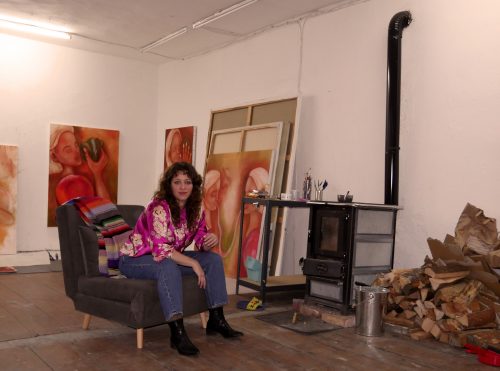
Groupshow
subliminal archipelagos

Nina Hartmann, Divination Wheel (Handheld Lie Detector, ESP Potential Network), 2024 Encaustic Me- dium, Pigment, Inkjet Print on spinning wood panel, 127x136x6 cm, 50x53.5x2.5 in
Advertisement

Nina Hartmann, Divination Wheel (Handheld Lie Detector, ESP Potential Network), 2024 Encaustic Me- dium, Pigment, Inkjet Print on spinning wood panel, 127x136x6 cm, 50x53.5x2.5 in

Jay Payton, The Eternal Symbol, 2024 Oil on canvas, 183x152,5 cm, 72x60 in

Nina Hartmann, Orgone Accumulator Diagram, 2024 Resin, Pigment, Acrylic paint, UV print, 47x47x2,5 cm, 18.6x18.6x1 in

Jack O’Brien, Hearts on Ice, 2024 Soft pastel, spray paint, photographic print mounted on aluminium, he- at-formed PETG plastic, chrome-plater steel, epoxy putty, 87x23x120 cm, 34x9x47 in

Jack O’Brien, Hearts on Ice, 2024 Soft pastel, spray paint, photographic print mounted on aluminium, he- at-formed PETG plastic, chrome-plater steel, epoxy putty, 87x23x120 cm, 34x9x47 in

Nina Hartmann, Polkadot Dress Conspiracy Mapping (Directional, Signage), 2024 UV print on Vinyl, Steel Frame, Zip Ties, 203x124 cm, 80x49 in

Jay Payton, As The Hands from Heaven Reach Down to You on Judgement Day, 2024 Oil on canvas, 132x111 cm, 52x44 in

Marie Matusz, Between Nostalgia and Anticipation, 2024 Solvent UV resistant ink on Pictorico film, 43,5x31 cm, 17x12 in each

subliminal archipelagos at Clima, Milan, Exhibition view

subliminal archipelagos at Clima, Milan, Exhibition view

subliminal archipelagos at Clima, Milan, Exhibition view

subliminal archipelagos at Clima, Milan, Exhibition view

subliminal archipelagos at Clima, Milan, Exhibition view

subliminal archipelagos at Clima, Milan, Exhibition view

subliminal archipelagos at Clima, Milan, Exhibition view

subliminal archipelagos at Clima, Milan, Exhibition view

subliminal archipelagos at Clima, Milan, Exhibition view

subliminal archipelagos at Clima, Milan, Exhibition view

subliminal archipelagos at Clima, Milan, Exhibition view
It appears clear that with the term archipelago we want to refer from the outset to a geography of bodies that are separate from each other, sometimes isolated, but with comparable features that it seems impossible not to read their union and the resulting relationship.
Subliminal archipelagos embrace a collection of works related to one another while not showing direct aesthetic evidence but emphasizing interactive processes of exchange that, just as in an archipelago, never occur hierarchically.
Loaded with visual stimuli and disparate sets of information, the exhibition becomes a shared visual experience in the navigation and discovery of individual exhibited units. Jay Payton’s large abstract canvases in which stain of colors and multiple layers of oil paint seem to outlie familiar patterns and lines, create real cartographies within them, similar to organic circuits capable of connecting with each other. Nothing becomes programmatic and programmed in the process of Payton’s works except a recurring gesture in the constant attempt to understand the human experience.
Analogous becomes the manipulation that Jack O’Brien adopts in the use of materials by returning them deformed, distorted and deconstructed, not only in appearance but in the rich conglomerate of meanings or languages. The object finds itself trapped within its final form constrained even by this thin transparent and reflective membrane of deformed plastic, which simultaneously accentuates its morphology but prevents its full reading. Hearts on Ice, 2024 certainly aims to reflect on the more concurrent complexities experienced and related to the production of desire under the actual lens of extensive consumption culture.
Through Nina Hartmann’s works, we are voluntarily exposed to a system of information, textual and photographic, which the artist collects, processes, and returns in the form of resin sculptures, encaustic decorated panels and vinyl screens. While Hartmann’s visual code uses symbols understood as objective data of information (like crosshairs, framing lines and diagrams) it also draws on a complex symbolic system secularly and spiritually associated with mysticism and esotericism. The visual stimuli, sometimes scientific and technological other times photographic prints of evanescent figures, put the spotlight on Hartmann’s investigation of systems of control and surveillance.
If we then add a temporal level to the concept of archipelago, it alludes to a cycle of relationships and coexistences that repeat and reinvent themselves, changing and altering but persisting as a collective entity. Composed of four Pictorico film prints framed in sequential plexiglass sheets, Between Nostalgia and Anticipation,2024 is Marie Matusz’s new work that develops a choreography based on a blurred presence. Stories, reflected and refracted, are a guiding element as brief glimpses into a user’s life and the present is exhausted in the very moment of its perception by becoming past. In this view of reality we measure the past as memory in which the digestion of loss, understood as separation, drives us to an anticipation of the unknown potential that might be.




